Join me today as I wrestle with the age-old Commander question: What’s better, ramp or card draw? It’s a question that has a little more nuance than you might think, and in the process of coming to a conclusion, I think I’ve hit on some key heuristics that can help you decide which is best for you.
Ramp & Card Draw
Ramp and card draw are two intrinsic columns of deck building, and perhaps two of the most important facets that Commander decks share. Whether that’s mana dorks and fast mana, generating oodles of mana with a Cabal Coffers or Black Market, or just playing a Wood Elves, all decks enjoy different types of ramp. The same goes for card draw, too — without seeing your cards, how do you expect to play them?

I recently covered five reasons your Commander deck might not be performing, and the most popular reasons — and the two solutions that can have the biggest impact — were, unsurprisingly, ramp and card draw. Along with removal and recursion, I would argue that ramp and draw make up the “Four Pillars of Good Deck Building” when it comes to Commander. I’ll cover removal and recursion another time, but for today, let’s look at ramp and draw.
Which is better? Well, let’s try to figure it out.
Ramp in Deck Building
Ramp’s importance has increased in the format in recent years, but it also tends to increase in importance on an individual basis the longer a player has been invested in the format. Players might initially pick tribes with high average mana values like Dragons or Angels or Sea Monsters (Krakens, Leviathans et al.), or pick commanders themselves that have a high mana value. These are the splashy and interesting cards, and the ones that often excite new players the most.
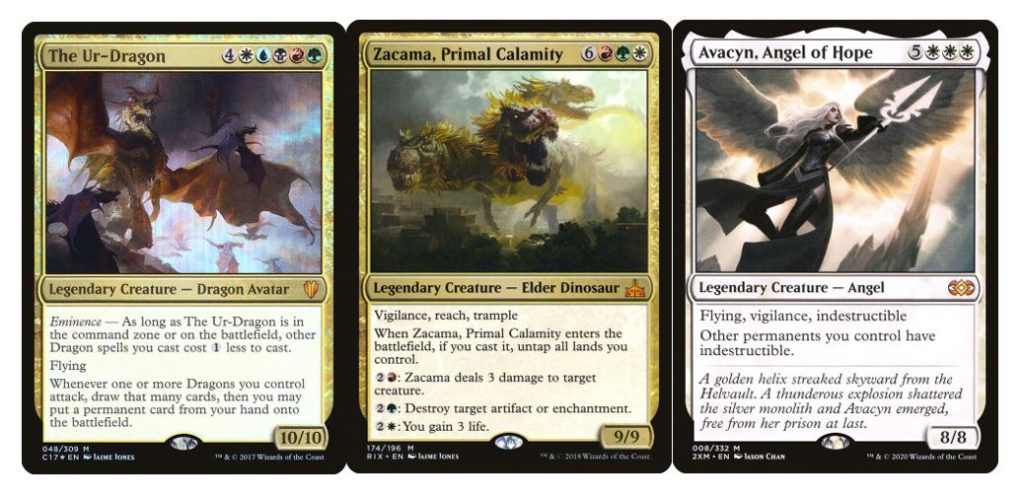
If those players stick with the game, they’ll soon learn that they’re losing games because they can’t get their commander or their creatures out on time. This is quickly remedied by jamming more ramp into the deck, increasing the chances they’ll be able to get into the game at a reasonable pace.
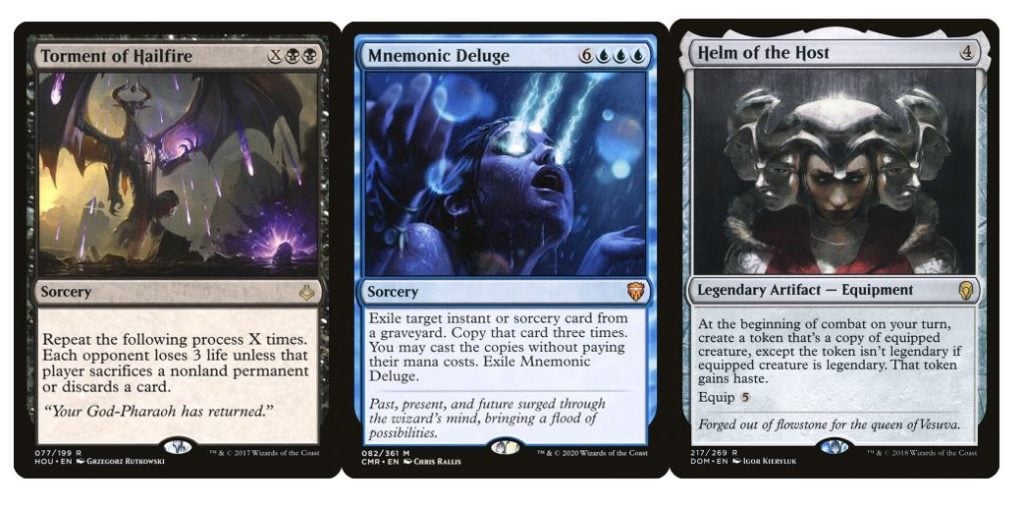
After that initial experience, those players will often find themselves building to a template that includes a specific amount of ramp. Casting expensive haymakers isn’t the only thing that requires ramp, though. Finisher spells and other wincons need a bunch of mana to get going, and reliable access to 10+ mana in the mid to late game becomes the goal, with many decks opting to aim higher if they can.
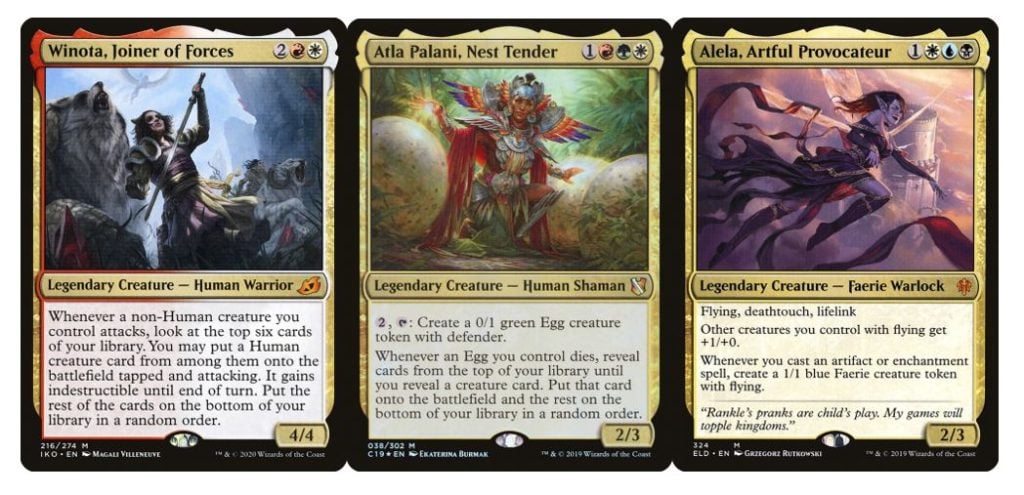
There’s also the fact that the format is dominated by powerful four- and five-drop commanders. Getting these commanders into play as early as possible is a definite advantage, and for some decks? It’s crucial to their game plan. Commanders like Winota and Kaalia want to be in play on turn three to start accruing value; Korvold, Yarok and Lord Windgrace can begin to set up an engine a lot quicker if they’re in play a turn early; even classic commanders like Meren of Clan Nel Toth and Atraxa, Praetors’ Voice want to be down as soon as possible, too. These decks revolve around their commander.
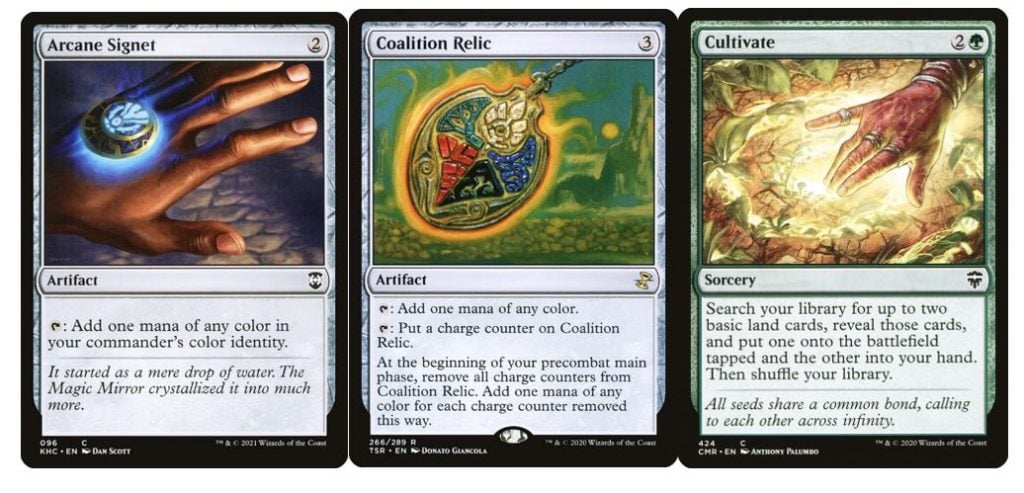
These decks often end up relying on particular ramp in particular slots. For four-drop commanders, ramp on turn two is super important. So, you’ll see Kaalia running a full suite of Signets and the likes of Fellwar Stone. Winota, meanwhile, runs mana dorks like Iron Myr and Ornithopter of Paradise — creatures that can both trigger Winota and help cast her. The five-mana commanders instead focus more on ramp on turn three, which can often accrue more value than spells that cost less, but still help with the game plan of getting a commander into play a turn early. They’ll still play ramp on turn two, but they have an extra turn of luxury, generally speaking, to get their ramp going.
Ramping to a Goal
I’ve spoken a little about how deck building needs dictate the importance of ramp — but what about the format itself?
The biggest reason to be ramping (at least, in my opinion) is to hit that sweet spot where you can comfortably cast two spells a turn. Being able to hold up interaction while progressing your own board state is the point at which the game tends to begin in most games of non-competitive EDH, and it’s where decks and players can truly begin to shine.
Being able to cast two spells a turn should be achievable in most decks, and regardless of whether you’re ramping into an expensive or early commander, you’ll want to be playing some amount of ramp to make this happen.
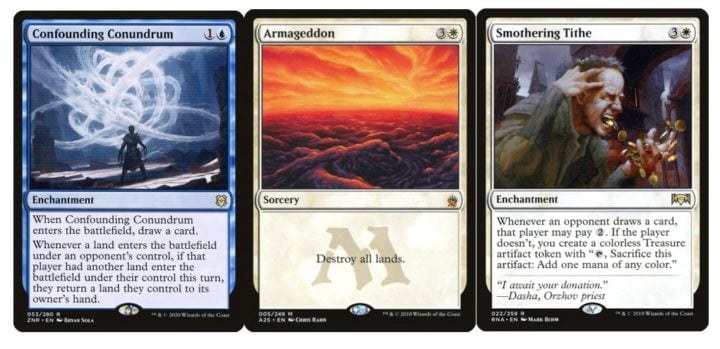
One other factor that can’t be ignored when it comes to ramp is the casual approach to stax at Commander tables where winning isn’t the only goal. Confounding Conundrum is a card I’ve not seen very often, but its presence has undoubtedly had an impact on how I approach games.
People aren’t generally going to be playing many stax pieces or hatebears at more social tables (and I use that word purposefully) because they sometimes lead to a more staccato game experience. Mass land destruction also crops up less frequently, too, which helps to foster an environment where ramp isn’t punished — and, if anything, it thrives. For this reason, taking time off in the developing stages of a game to ramp doesn’t tend to leave the shields down as much as it would in a more cutthroat environment. One only needs to look to cEDH to see how this plays out to the logical conclusion: you take time off to dither about, and somebody has already threatened to win the game.
Ramp, then, is quite literally free real estate in more casual or social Commander environments. If you’re not punished for doing it, then why not join in? It can help to make a deck hum, after all.
Card Draw
Card draw, on the other hand, is a different beast entirely. Card draw is still often seen as the domain of blue and green decks, despite black having more than enough card draw to sate its needs, and despite the increase in red’s impulsive draw options over the past few years.
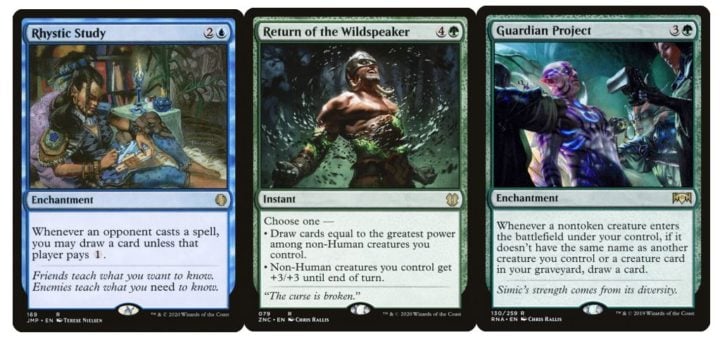
I think this largely comes down to the fact that blue and green rely less on refill draw, and can get by with topping up easily and cheaply as a game progresses. Instead of casting Reforge the Soul or Stinging Study, Simic decks can drop Beast Whisperer, Tatyova, Benthic Druid or Mystic Remora to keep the cards coming with very little effort.
While black does have ways to draw cards besides conventional card draw spells, it often relies on paying life or having creatures pass in and out of the graveyard. These both require more resources than blue or green need, and/or they require spending the resources required to try to find the win. Even in the simplest of combat decks, green and blue can just attack and draw cards for attacking or damaging players… hell, for even casting those creatures.
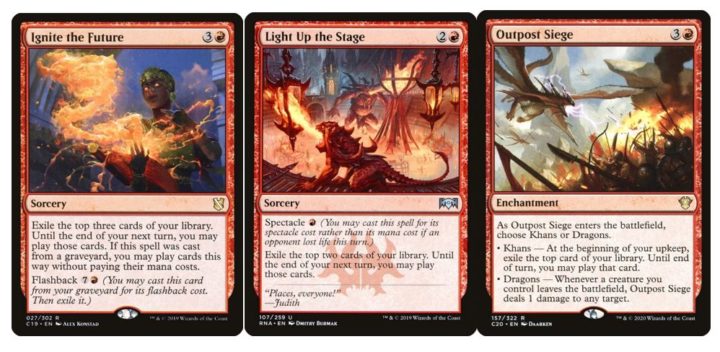
Red, meanwhile, has to pin a lot on hitting the right cards with impulse draw. Impulse draw is rarely the best option in red decks that require combo pieces or that have reactionary interaction. In Boros decks running cards like Teferi’s Protection, for example, impulse draw still lags behind the other options. White is starting to see some good draw options, but remains behind the other colors.
I say all this to point out the importance of card draw in a 100-card format. Obviously, seeing your combo pieces is hugely important, and if you’re running that kind of build, you’ll already be jamming as many tutors and draw options in your deck as you can justify. Even outside of this kind of deck, though, card draw is still crucial to a deck’s performance.
Most decks set a benchmark for how many pieces of ramp they play — not because they necessarily need that many, but to increase the likelihood of seeing some in the developing stages of a game. The same is true for the other pillars of deck building: draw, removal, and recursion.
Most players don’t realize that only one of those four pillars can be increased without detriment to the others: card draw. Adding more card draw in place of any of the other categories has the least effect on your game plan. But draw, removal and recursion differ from ramp in that you just need to see them in order to benefit, and they rarely matter in the developing stages of the game.
I’ve often talked about redundancy being one of the key measures of a deck’s success. I’ve also gone on record saying that green getting to explore new design space is the price we have to pay for the color getting even stronger through redundancy. By running enough card draw, you can stand to lower your overall redundancy of effects. Drawing more cards allows you to hit the key pieces you need more often — whether that’s removal, recursion, or even ramp.

By adding more card draw, you can ensure you see your removal and recursion more often — your interaction and counterspells — and chain that draw into more draw. It’s what makes running Wheel effects so great: you can often keep going and never run out of cards, even when you’re not in a dedicated Wheel-wincon build.
More Benefits to Evaluating Card Draw
The main benefit to having more cards in hand is, of course, having more options. It’s why Simic decks regularly opt to “Draw 25.” Trying to go off without at least two counterspells? Why bother?
Jokes aside, there’s merit to that way of thinking. You’re going to close a game more often if you have trump cards in hand, and nobody can be blamed for opting to play that way. In order to ensure you’re flying on favorable winds more often, you can do the same thing you’d do to ensure you don’t hit dry spots during a game. Run. More. Card Draw.

My Aurelia, the Warleader deck has enjoyed many upgrades in the past year or two, and they have predominantly been in the card draw department. The deck runs far smoother than it used to when the main sources of draw were Wheel of Fortune, Magus of the Wheel, Reforge the Soul, Tome of Legends and Mask of Memory.
By assessing the weaknesses of the colors your deck is running — and, by association, the type of draw effects you’re relying on — you can account for gaps in deck building. If you’re predominantly running bursty draw or looting in a graveyard-based Rakdos deck, for example, it still might be correct to run cards like Night’s Whisper, Dark Bargain or Ambition’s Cost if you aren’t already. It might look like the blue player isn’t doing much when they cast a mid game Frantic Search or Thirst for Meaning between bigger draws, but these cards are often the glue that holds together the burstier or more productive draw engines.
There’s also something to be said for seeing the full curve of your deck more often. If you have seven mana and several cards you could play at different mana costs, you’re in a better situation than if you had multiple four or five-drops stuck in your hand. By drawing more cards, you’ll run into this situation less often.
So, What’s Better: Ramp or Draw?
I’m going to give a less-than-straightforward answer here. Or, rather, answers.
My first cop out, of sorts, is to say that what’s better for you will wholly depend on what your deck needs after some actual playtesting. If you’re trying to hit key points on the curve, cast expensive spells, or hit two-spell turns as soon as possible, you’ll want to prioritize ramp.

Ramp is important even in non-green decks. It’s why white decks in particular still run the likes of Solemn Simulacrum and Burnished Hart, and why cards like Archaeomancer’s Map are so exciting. Ask yourself: am I getting to cast the spells I want to? If the answer is no, it’s likely you want to concentrate on ramp.
Otherwise, jamming more draw is likely the best way to improve your deck. Like I mentioned above, having more ways to smooth out your draws goes a long way to hitting those burstier refills or those card draw engines through the course of a game. More draw helps you hit the removal, the interaction, and the recursion you need, without sacrificing as many deck building slots as you would for ramp.
Prioritize Whatever Lets You Hit Land Drops
My other answer is to play more of whatever lets you hit land drops.
If you concentrate on land-based ramp that takes land out of the library, you run the risk of missing land drops as the game goes on, especially if you aren’t running enough lands in the first place. This can lead to a fast start, with a gradual tapering of potential as the game goes on.
Many of my friends joke about how I play Boros “in a Sultai way.” It’s not uncommon for my decks to be sitting with fourteen lands or more at the tail end of the game — often more lands than the green decks.
By playing both enough lands and enough card draw, you’ll ensure you can hit those land drops every turn without flooding. It’s the goldilocks zone you’re aiming for, and once you can get that ratio just right, you’ll feel like your deck can accomplish anything.
Spending the most mana is usually a good predictor of who wins a Commander game, but without hitting your land drops, you’re going to fall behind. While I will always advocate for running more lands (at least 37-38, ideally), I think it’s far easier to convince people to instead dedicate lands 36-38 upwards to more card draw. Card draw will help you hit those land drops.
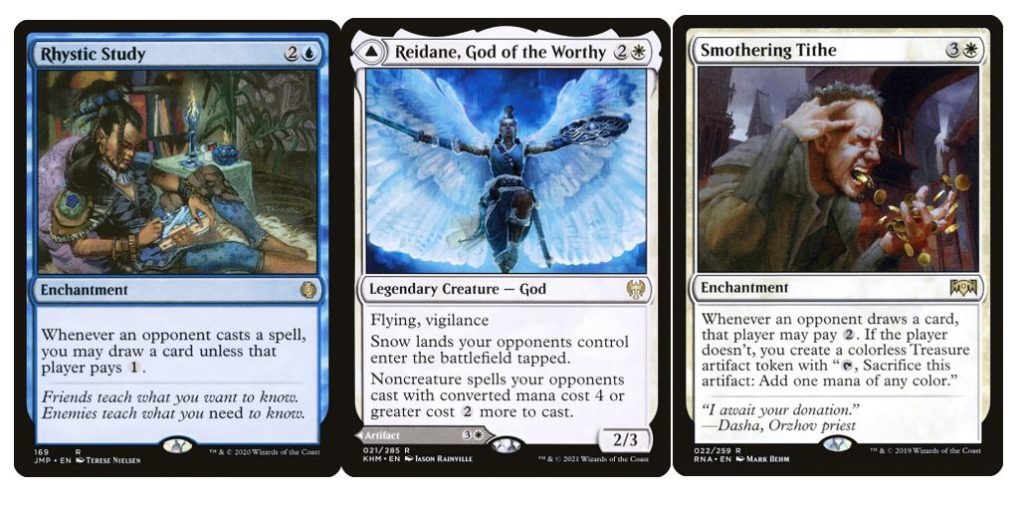
Making land drops every turn also means you’re less likely to fold under pressure of light or even heavy stax pieces. You’ll be able to pay the 1, the 2, and sometimes even the 4. Above all, always remember that playing a land is a free action. By running fewer lands, and relying only on mana rocks and ramp spells, you’re actually endangering your tempo. If you fall too far behind? You’re out of the game.
So, in short: while ramp and draw are both amazing, I’d prioritize whichever helps you make your land drops. You’ll thank me later.
What do you think? Let me know on Twitter.

Kristen is Card Kingdom’s Head Writer and a member of the Commander Format Panel. Formerly a competitive Pokémon TCG grinder, she has been playing Magic since Shadows Over Innistrad, which in her opinion, was a great set to start with. When she’s not taking names with Equipment and Aggro strategies in Commander, she loves to play any form of Limited.

